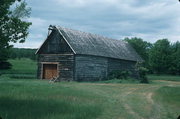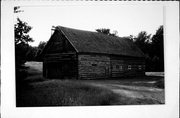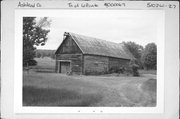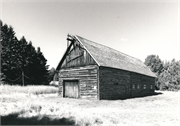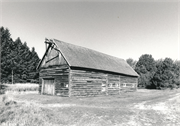Property Record
E 3960 KRON-DAHLIN
Architecture and History Inventory
| Historic Name: | Charles Kron Barn |
|---|---|
| Other Name: | |
| Contributing: | |
| Reference Number: | 67 |
| Location (Address): | E 3960 KRON-DAHLIN |
|---|---|
| County: | Ashland |
| City: | |
| Township/Village: | La Pointe |
| Unincorporated Community: | |
| Town: | 51 |
| Range: | 2 |
| Direction: | W |
| Section: | 27 |
| Quarter Section: | SE |
| Quarter/Quarter Section: | SE |
| Year Built: | 1910 |
|---|---|
| Additions: | |
| Survey Date: | 1993 |
| Historic Use: | barn |
| Architectural Style: | Astylistic Utilitarian Building |
| Structural System: | Log |
| Wall Material: | Log |
| Architect: | |
| Other Buildings On Site: | |
| Demolished?: | No |
| Demolished Date: |
| National/State Register Listing Name: | Not listed |
|---|---|
| National Register Listing Date: | |
| State Register Listing Date: |
| Additional Information: | A 'site file' exists for this property. It contains additional information such as correspondence, newspaper clippings, or historical information. It is a public record and may be viewed in person at the Wisconsin Historical Society, Division of Historic Preservation. ROUND LOGS ON LONG 3-PART STRUCTURE. HANGING GABLE. In the 1890s, a wave of immigrants from Scandinavia came to Madeline Island to work in a lumber camp, but before long they established subsistence farms. Among these immigrants was Charles Kron, a Swede of Finnish-Swedish heritage. His wife, Olivia, joined him in 1899, and between 1905 and 1910 the Krons acquired this farm. Family tradition holds that Charles built this barn himself, but the previous owner’s son, Gust Dahlin, may have assisted him, for Dahlin was reputedly a highly skilled carpenter. The barn, composed of three sections, used the tongue-and-groove and dovetail joinery technique that distinguishes Scandinavian log barns. First the builder cut the sides with a broadax or adze to produce flattened surfaces. Hewn walls are easier to make weather-tight. He then cut a groove the length of the underside of the log and shaped the top to fit, so that the grooved side rests on a rounded, convex edge. The full dovetails testify to the builder’s woodworking skills. Over the years the logs warped, requiring masonry chinking where moss or fabric originally caulked the joints. |
|---|---|
| Bibliographic References: | Buildings of Wisconsin manuscript. |
| Wisconsin Architecture and History Inventory, State Historic Preservation Office, Wisconsin Historical Society, Madison, Wisconsin |

